Book contents
- Frontmatter
- Contents
- List of tables
- Acknowledgements
- Introduction
- 1 Foreign investment: a neglected variable
- 2 The use of foreign workers
- 3 The new immigration
- 4 The globalization of production: implications for labor migration
- 5 The rise of global cities and the new labor demand
- 6 The reconcentration of capital in the United States: a new investment zone?
- Conclusion
- Notes
- References
- Index
4 - The globalization of production: implications for labor migration
Published online by Cambridge University Press: 04 April 2011
- Frontmatter
- Contents
- List of tables
- Acknowledgements
- Introduction
- 1 Foreign investment: a neglected variable
- 2 The use of foreign workers
- 3 The new immigration
- 4 The globalization of production: implications for labor migration
- 5 The rise of global cities and the new labor demand
- 6 The reconcentration of capital in the United States: a new investment zone?
- Conclusion
- Notes
- References
- Index
Summary
Why did high outmigration from various countries discussed in the preceding chapter occur at a time when these countries had high industrial growth rates and major increases in direct foreign investment while the U.S. economy was marked by growing unemployment and inflation? The overall levels of entries for Asian and Caribbean Basin immigrants kept growing in the 1970s, a decade when unemployment was particularly high in the U.S. and the recession was headlined in major newspapers throughout the world. During that same period the main immigrant-sending countries had growth rates of about 5 to 9 percent in GNP and even higher in manufacturing.
The high GNP growth rates in sending countries were in good part due to large increases in direct foreign investment from the major industrial countries. A growing share of such investment from advanced industrialized countries is going into industries producing for export. Export industries tend to be highly labor intensive, this being precisely one of the rationales for locating factories in low-wage countries. The evidence shows rather high employment growth, particularly in manufacturing, in several of the Asian and Caribbean Basin countries that have been major recipients of direct foreign investment for export-oriented production. These are also among the main immigrant-sending countries.
- Type
- Chapter
- Information
- The Mobility of Labor and CapitalA Study in International Investment and Labor Flow, pp. 94 - 125Publisher: Cambridge University PressPrint publication year: 1988



